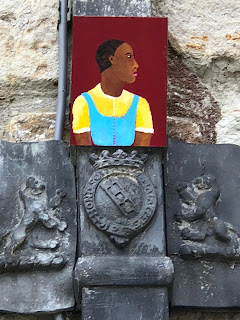I felt like a bad student when I got to class. I felt I had not done enough homework! I'd not found many artists who acknowledged using archives. I had looked at a couple of artists, Lubaina Himid, and Nigel Cheney, but was not sure how to use what I'd seen from these artists who used archives. I'm not particularly struck by Himid's style of work, but I loved the work I saw at Knole NT, where she had researched a 'blackamoor' laundrymaid, and put small artworks on the drainpipes. It represented an unseen and undervalued woman, and put her skills and talents in an unusual place, in full view.
 |
| Lubaina Himid, |
 |
| Lubaina Himid |
Nigel Cheney is working on WW1 army uniforms. I'm not inspired by war commemorations but I do like how he works with materials symbolic of specific people. I will get photos from Knitting & Stitching show this weekend - as I am failing to lift them from the internet. The series is called Body Bags - using repurposed WW1 uniforms - so I like the play on words.
In class we looked at inspiring artists who had exhibited this week at the Triity Buoy Drawing Prize. I was inspired by Tim Shore, who had made a double spine book, and who is "grounded in materials, making and process". I thought about my Ford Machinist women, and how their work was undervalued in comparison to men. What about a double spine book with a man's side and a woman's side? I had bought a 1968 Haynes Guide for a Ford Cortina, so I had some 'man paper' and some dressmaking pattern with words related to women, for 'woman paper'. I cut 10 sheets of man paper, and 8 sheets of woman paper, as the women were on 84% of the equivalent male rate of pay. I used the cover sheet of the Haynes guide for the man's cover to my handmade book, and punched paper with the 'he can't even thread a sewing machine' design for the woman's side. I folded the pages to have a two-third to one third spacing for the spines for the right and left pages.
 |
| Haynes Guide for a Ford Cortina, ready for cannibalising |
 |
| Book making with men's and women's papers. |




No comments:
Post a Comment